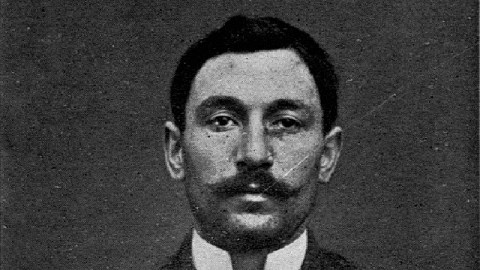How Vincenzo Peruggia Created the Mona Lisa—by Stealing Her

He made more money as a handyman than as an artist, but Vincenzo Peruggia’s personally responsible for making the Mona Lisa what it is today. Leonardo da Vinci painted Lisa del Giocondo in the early 16th century, but Peruggia made her famous worldwide by walking out of the Louvre with the painting wrapped in his smock on August 21, 1911, one hundred years ago today. With that daring daylight robbery, the Mona Lisa began her ascent into the stratosphere of cultural fame, while Peruggia (shown above, in his police photo) sank further and further into the hazy mists of vague infamy. How and why did Peruggia do it? More importantly, what would have happened if he hadn’t?
Peruggia came to Paris in search of a life in art, even if it was only as a part-time worker in the Louvre. Like many other Italians, Peruggia sought greater opportunities in the City of Lights only to find himself disparaged by the locals as “sale macaroni,” French for “dirty macaroni.” Wounded by prejudice and longing for home, Peruggia, as he later claimed, stole back what he mistakenly thought Napoleon had stolen from Italy a century before. In reality, Leonardo sold the painting to Francis I after moving to France to become court painter. But why did Vincenzo really do it?
In The Missing Piece: Vincenzo Peruggia and the Unthinkable Theft of the Mona Lisa, writer and director Joe Medeiros cinematically searches for the answer to that question. (You can see the film’s trailer here.) Medeiros enlists the help of Peruggia’s descendants, including his daughter and grandchildren, to track down the truth—whether it be the often-invoked patriotism motive or a more nefarious profit motive. One less-noble theory has Peruggia stealing the painting for a con man who planned to sell six copies to wealthy investors while the real work was missing. (SPOILER ALERT. Skip to next paragraph if you plan to see the movie, which is still seeking a distributor.) Sadly, when Medeiros’ research unearths Peruggia’s letters that the police had taken as evidence, those letters reveal that Peruggia stole the Mona for the usual reasons—money and fame.
Noah Charney, international authority on art crime as founder and president of the Association for Research into Crimes against Art (ARCA), also takes on the art crime of the centuries in his new book, The Thefts of the Mona Lisa: On Stealing the World’s Most Famous Painting. In addition to analyzing the how and why of the theft, Charney goes into the pre- and post-Peruggia lives of La Gioconda. Even before the heist, da Vinci’s work drew praise ranging from contemporary Giorgio Vasari, who gave the painting it’s name, which means approximately “Lady Lisa,” to 19th century essayist Walter Pater’s prose poem to the “Lady of the Rocks.” “Mysterious, beautiful, iconic, and the work of a true universal genius, the Mona Lisa was once again celebrated, already among the most famous paintings in the world,” Charney writes of the power of Pater’s paean. “And it hadn’t even been stolen yet.” Before Peruggia, the Mona Lisa stood among the greatest paintings in the world. After his act, followed by the search and recovery two years later, Mona left the rest far, far behind. Charney tells the tale with his trademark breathless flair and eye for fascinating detail, in this case episodes such as Picasso’s being questioned about the theft and Mona’s “missing years” during World War II when the Nazis may have taken her as part of their rape of Europa’s art treasures.
Peruggia held onto the painting for nearly two years before contacting art experts in Italy about selling her. During those two years, Mona-mania gripped Europe, ginning up the painting’s cultural cache. Peruggia served a short jail sentence while Mona toured Italy before triumphantly returning to France. While fighting for Italy in World War I, Vincenzo began answering to Pietro. After the war, Pietro Peruggia married, moved back to France, opened his own paint store, and lived in obscurity with his family until his death in 1925. (When a different Vincenzo Peruggia died in 1947, some obituaries mistook him for the real thief.) Peruggia died believing that he’d live forever as the man who stole the Mona Lisa. That he never received that reward may have been the worst penalty for his crime.
When I asked Noah what museums today should take away from the Peruggia case, he replied, “The biggest lesson to learn would be that wishful thinking, hubris, and lethargy lead to security problems. The Louvre had been robbed on multiple occasions in the decades prior to 1911 and the museum had done nothing to ramp up security until it was too late.” Just earlier this month, a thief took a Rembrandt drawing literally from under a curator’s nose, proving that security hasn’t come too far in a century. What art lovers should take away is just how constructed the Mona Lisa’s fame is, and what the price of that fame is. “Despite its renown, the Mona Lisa is what has been called an “invisible” icon—something so famous that people have ceased to really look at it or know anything about it beyond its title and creator,” Charney believes. “Next time you go to Paris, by all means visit the Mona Lisa. Take a picture, if you like. But when you stand before it, take a moment to really look. Share the space, consider its history, the miracle of its survival, and think about why it is famous. The reward will be far greater for the time spent in contemplation and admiration.” Mona’s everywhere, yet nowhere at the same time, at least in any true sense. What Peruggia really stole from the world may be the chance at that authentic, unfiltered look at da Vinci’s portrait. A century later, the time has come to take it back.
[Many thanks to Noah Charney for answering my questions and providing me with a review copy of The Thefts of the Mona Lisa: On Stealing the World’s Most Famous Painting.]





